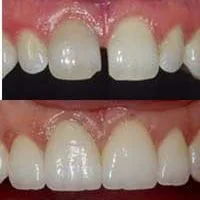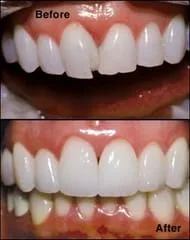
|
Closing a Dental Gap (Diastema) Tooth bonding can be used to fill in gaps that lie between a person's teeth (dentists call this type of gap a "diastema"). When this technique is employed, dental composite is bonded onto the sides of the two teeth that lie on either side of the gap, so to widen each tooth slightly. The net effect is that the space between the two teeth is narrowed, or even filled in completely. |

|
Dental Composite Fillings for Front Teeth Dental composite (the restorative that is used with tooth bonding technique) comes in a wide range of different tooth shades, it will typically mimic the color of the tooth on which it is placed very closely. |

|
White Fillings for Back Teeth In some instances dental composite can be an appropriate restorative for fillings placed in back teeth. Patients often like this option because the white color of composite fillings is much less noticeable than the silver coloration of dental amalgam fillings. |
Home Care Instructions After Cosmetic (White) Fillings or Bonding:
When an anesthetic has been used, your lips and tongue may be numb for several hours after the appointment. Avoid any chewing and hot beverages until the numbness has completely worn off. It is very easy to bite or burn your tongue or lips while you are numb.
It is normal to experience some hot, cold, and pressure sensitivity after your appointment. Injection sites may also be sore. Ibuprofen (Motrin), Tylenol or aspirin (one tablet every three to four hours as needed for pain) work well to alleviate the tenderness. If pressure sensitivity persists beyond a few days or if the sensitivity to hot or cold increases, contact our office.
You may chew with your composite fillings as soon as the anesthetic completely wears off. Composite fillings are fully set when you leave the office.
If your bite feels uneven, if you have persistent pain, or if you have any other questions or concerns, please call our office at (203) 272-9694.















